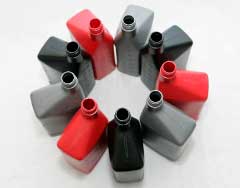Types of Automotive Fluids - Vol.107
Take a deeper look into your car, give it a little thought and you will realize that a car might be one of the most complex machines ever built by humans. It is not quite possible to explain the complete working of a car's internal system in a single page, yet one thing is for sure. When the engine starts running, thousands of tiny or large parts start moving inside the car. This is the reason your car needs proper lubrication and cooling in order to run smoothly.
However, each part of the car moves or works in a different manner and requires different level of lubricant with different properties. This is the reason you cannot possibly substitute engine coolant with motor oil or vice versa. So, here is a little explanation as to what makes each engine fluid different and how you can actually identify that difference.

Engine/Motor Oil
The purpose of engine oil is to reduce friction between moving parts of the engine itself. It protects the engine from wear and tear and over-heating. However, it is very important to ensure the oil itself is clean from impurities and particles. That is why it is always recommended to change the engine oil after every 3500 miles or so. Also, you should keep the oil filter clean and replace it whenever deemed necessary.
The viscosity of engine oil is denser than the regular cooking oil in our kitchen. Various brands add different coloring to their products and therefore it can range from clear or light brown tint to a darker brown or black color.
Coolant/ Anti-Freeze
When the engine gets too heated, it is not possible for the engine oil alone to control the temperature. The radiator is where the heat extremes from the engine are transferred to. For this purpose, radiators have a special liquid with amazing cooling properties. This is what we usually call anti-freeze or coolant.
Coolant is water with added additives (ethylene glycol) bearing a very low freezing point and a very high boiling point. Due to this property, they are able to handle up to 300 degrees, i.e. the extent to which your engine can heat up at times.
Automatic Transmission Fluid ATF
If you are driving a self-shifting car, you don't have to worry about shifting gears at every nook and corner, but you do have to worry about one more fluid - the Automatic Transmission fluid. ATF is a specialized lubricator formulated to handle valve operations and brake-band friction inside the automatic transmission. It also works as a lubricator for gears inside as well.
ATF contains performance enhancing chemicals and there are many variations to meet the specific needs of different self-shifting transmissions. This fluid usually has a pinkish to red tint, or in rare cases green. Due to its special properties, it is also used as a hydraulic fluid in the power steering system. In these systems, ATF keeps the hydraulic pump run smoothly in order to optimize maneuverability. ATF must be replaced within the specified period in order to avoid costly transmission issues.
Brake Fluid
When you hit the pedal, a fluid is pumped from the pedal to the brake in order to bring your car to stop. The purpose is to provide the brakes with the pressure and power required to stop your car. Due to the presence of rubber inside the brake system, this fluid is not petroleum-based. It can be glycol-ether, silicone or mineral oil based. Major properties of brake fluids are its very high boiling point and very low compressibility.
You should always maintain the quantity and quality of this fluid in your car. It is recommended to change the brake fluid every two to three years.